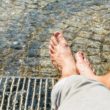Alternative
The climb to the top of Mount Bishop and Clerk, the highest point on Tasmaniaâs Maria Island, is said to reward adventure travellers with panoramic views over the top of the islandâs eucalypt forests and out across the Pacific Ocean.
To the north, we’re told, lies the Australian mainland; to the south, over the distant horizon, lies the icy landscapes of Antarctica.
We take it on trust. Because the peak we’ve conquered on this tiny island off the coast of Tasmania, which in turn is an island off the coast of mainland Australia, is a cloud-covered triumph.
We hear the ocean and the wind, we can even smell its Antarctic purity, but we can see not much further than armâs length. Thatâs enough, though, to peer warily over the edge of the peak and see the beginnings of a sheer drop that leads to oblivion.
A few steps back from the edge sits the climbâs other reward: a stash of chocolate and extra water that our guide Ben has lugged with him from the morningâs departure point, Bernacchi House.
Bernacchi House provides a warm welcome for participants in the three-night, four-day Maria Island Walk. Having spent the previous two nights camping out, guest arrive at Bernacchi House to be greeted by an open fire in the hearth, a sumptuous dinner, and a blissfully warm shower. A deep and restful sleep follows as surely as night follows day.
Not that the previous nightsâ camping out involved much hardship. In fact, the tents we slept in were more like up-market huts, complete with polished timber floors and screened windows. Each of these huts are positioned discreetly among the gum trees, connected via boardwalks to the dining hut, where we feasted like bush royalty.
A copy of the menu souvenired after our first night on Maria Island reminds me of just how well we ate: Shitake mushroom soup, followed by grilled quail with a spiced couscous and an eggplant ratatouille, then chocolate mud cake with a berry coulis and cream.
Wildlife abounds on Maria Island. Kangaroos, wombats and wallabies are everywhere, making Maria Island a great destination for travellers keen to experience Australian fauna in its natural state.
The island is also home for the elusive 40-spotted pardalote, a very shy bird endemic to the region and much loved by amateur and professional bird spotters.
A colony of fairy penguins also call the island home, and these can be spotted on a night walk from Bernacchi House.
Walking on Maria Island gives us time to be part of this natural environment, rather than merely look at it. We amble along deserted beaches, wander through paddocks where pug-nosed wombats graze unconcernedly, and we take time to enjoy phenomenon such as the magnificently patterned Painted Cliffs.
Embracing the prevailing weather conditions is part of the experience, and although the postcard views largely eluded us, the overcast skies and occasional drizzle added a moodiness that was both melancholic and atmospheric.Â
We learnt to pay attention to the detail rather than the big picture. We photographed fossilised sea creatures, feeling a million years of history as we ran our fingers over the fossilâs Braille-like crust; and we listened out for the call of the elusive 40-spotted pardalote.
Maria Island has heartbreaking tales aplenty. It used to be penal colony, and its museum in the small settlement of Darlington includes copies of newspaper reports alerting Tasmaniaâs free settlers to the details of yet another convict breakout.
The escapees ranged in age from 17 to 21-years-old, young Irish and English men who advised family back home that they, too, should get themselves transported to Tasmania because despite the bleak conditions, the new lives that could be built on the other side of the world were infinitely better than the ones theyâd left behind.
The guided four day Maria Island Walk is a quirky blend of history and nature, food and wine, luxury and adventure. It leaves a small footprint, thanks to the eco-friendliness of the base camps at Casuarina Beach (day one) and White Gums (day two) and the mindfulness of our guides who ensure we leave nothing behind but footprints.
At the end of each season, both camps are dismantled and the island is left to winter alone.
Getting to Maria Island Walk is an adventure in itself.
On the day of departure, weâre collected from our hotel in Hobart and kitted out with a backpack, waterproof jacket, a head torch, a silk sleeping sheet and a packed lunch.
Then thereâs a short drive to the seaside town of Triabunna, where we board a charter boat and cruise across the Mercury Passage to Maria Island. The boat weighs anchor a few metres offshore and we clamber into a dinghy for final leg of the journey.
Itâs a special beginning to an experience none of us wants to end.
Want more copyright-free stories about Australian destinations? Free stories and images are available at: =>http://www.media.australia.com
Therapy
FitLine – more power











